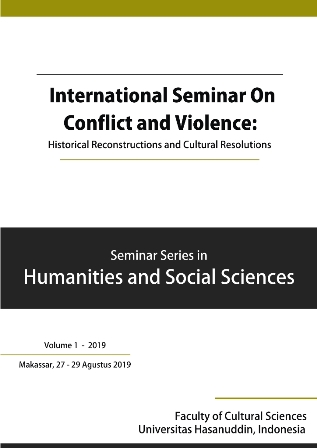WITHSTAND IN THE BORDER AREA: FARMER STRUGGLE “SUNGAITOHOR” RIAU PRESERVE IT’S LAND
Abstract
After the issuance of the Regional Autonomy Law in 2004, land concessions in the border area were of particular concern to the corporation. In addition to the changing and increasingly open situation, the land area has experienced a narrowing of space due to the ease with which the local government issues permits in both forest, mining and plantation land concessions (HGU). Even though full authority over large-scale land concessions is at the center, the recommendations of local governments largely determine the process of issuing "licenses/ rights". in reality, the "narrowing of space" in the land area must be transferred to other regions that are politically advantageous, far from the center of the crowd and public attention, namely the border area which is still considered non-monitored. This study would like to illustrate how the strategy of the community to survive and fight defends its land and manages the land on the basis of local wisdom to protect the ecology of peat forests belonging to the community. The model and strategy of struggle chosen are decisive in the level of success of the community in maintaining their land. This paper uses field studies with a "action" research approach involving actors and advocacy parties. As a result, Seven villages in Tebingtinggi Timur were included in the 10,390 hectare Industrial Plantation concession scheme. Successfully resisted and expelled the company which had been regarded as the party responsible for the ecological crisis and environmental damage. Another interesting finding is how the model and strategy of the Sungaitohor and surrounding communities fought and defended their land. The strategy promoted as a central issue is saving ecology and food with a collaborative approach from various parties. And finally, the issue succeeded in delivering "victory" to the local community, and "drive away" the company from Sungaitohor, Riau.Keywords: Sungaitohor, strategy for struggle, agrarian reform-social forestry
References
_____. (1991). Sengketa Agraria: Pengusaha Perkebunan melawan Petani. Jakarta: Sinar Harapan.
Afiff, S., Fauzi, N., Hart, G., Ntsebeza, L., Peluso, N. (2015). “Redefining agrarian power: Resurgent agrarian movements in West Java, Indonesia”, Center for Southeast Asia Studies.
Alfinanda, A. (2016). “Petisi Manan Buat Jokowi Datang”. [Online]. Available: http:// alfinandaagus.blogspot.co.id/2016/07/.
Aprianto, TC. 2016. Perjuangan Landreform masyarakat perkebunan partisipasi politik, klaim, dan konflik agraria di Jember, Yogyakarta: STPN Press.
Bachriadi, D. (2010). “Between discourse and action: Agrarian reform and rural social movement in Indonesia Post 1965”. Australia: Disertasi Flinders University.
Bachriadi, D. dan Lucas, A. 2001. Merampas tanah rakyat, kasus Tapos dan Cimacan. Jakarta: Kepustakaan Populer Gramedia.
Borras, S. 2005. La Via Campesina. Potret gerakan tani transnasional. Jakarta: Garis Pergerakan.
Denzin, NK and Lincoln, Y.S. (1994). Handbook of qualitative research. Sage publications, inc. (Edisi Terjemahan Pustaka Pelajar).
Firmansyah, T. (2014). “Asap Sampai ke Malaysia”, 18 Sep 2014 14:00 WIB. [Online]. Available: https://www.republika.co.id/berita/koran/halaman-1/14/09/18/ nc34sc5-asap-sampai-ke-malaysia.
Hadi, S. 2017. “Strategi dan kebijakan percepatan pembangunan daerah perbatasan melalui pengembangan investasi kawasan perbatasan pada daerah tertinggal dalam kerangka RPJMN 2015-2019”, Kementerian Perencanaan Pembangunan Nasional/BAPPENAS, Rapat Sosialisasi Bantuan Pemerintah Pengembangan Daerah Perbatasan Tahun 2017, Direktorat Jenderal Pengembangan Daerah Tertentu, Kementerian Desa PDTT.
Hafid, J. 2001. Perlawanan Petani: Kasus Tanah Jenggawah. Jakarta: Pustaka Latin.
Izwan (2015, Oktober). “Analisis pelaksanaan fungsi Badan Pengelola Perbatasan Daerah di Kabupaten Kepulauan Meranti Tahun 2011-2013”, JOM FISIP Vol. 2, No. 2.
Li, TM. 2012. The will to improve: Perencanan, kekuasaan, da pembangunan di Indonesia. Jakarta: Marjin Kiri.
Lucas, A., dan Warren, C. 2007. “The state, the people, and their mediators: The struggle over agrarian law reform in post-New Order Indonesia”. Indonesia, Edisi 76.
Muta’ali, L., Marwasta, D., Joko, C. 2014. Pengelolaan Wilayah Perbatasan NKRI. Yogyakarta: Gadjah Mada University Press.
Pelzer, KJ. (1985). Toean Keboen dan Petani: Politik Kolonial dan Perjuangan Agraria. Jakarta: Sinar Harapan.
Rachman, NF. (2013, April). “Rantai Penjelas Konflik-Konflik Agraria yang Kronis, Sistemik, dan Meluas di Indonesia, Bhumi No. 37 Tahun 12.
Salim, MN. 2017. Mereka yang Dikalahkan: Perampasan Tanah dan Resistensi Masyarakat Pulau Padang. Yogyakarta: STPN Press.
Salim, MN, Pinuji, S., Utami, W. (2018), “Reforma Agraria di Kawasan Hutan Sungai Tohor, Riau: Pengelolaan Perhutanan Sosial di Wilayah Perbatasan”, Bhumi, Jurnal Agraria dan Pertanahan, vol. 4, no. 2, Nov. hlm. 164-189.
Salim, MN. (2013, April). “Menjarah” Pulau Gambut: Konflik dan Ketegangan di Pulau Padang”, Bhumi No. 37 Tahun 12.
Salim, MN, Pinuji, S., Utami, W. (2018), “Reforma Agraria dan Perhutanan Sosial: Kebijakan Pengelolaan Hutan Desa dan Peluang Tora di Tebingtinggi Timur Kabupaten Kepulauan Meranti, Riau,” Laporan Penelitian, PPPM-STPN.
Sizer, N. dkk. (2013). “Kebakaran Hutan di Indonesia Mencapai Tingkat Tertinggi Sejak Kondisi Darurat Kabut Asap Juni 2013”, [Online]. Available: http:// www.wri.org/blog/2014/03/kebakaran-hutan-di-indonesia-mencapai-tingkattertinggi-sejak-kondisi-darurat-kabut.
Walliman, N. 2017. Research methods: The basics. Routledge.
Wijanarko, B. dan Perdana, H. 2001. Reklaiming dan kedaulatan rakyat. Jakarta: YLBHIRaca Institute.
Tempo. 25 Agustus 1979.
Suara pembaruan. 21 April 1997.

